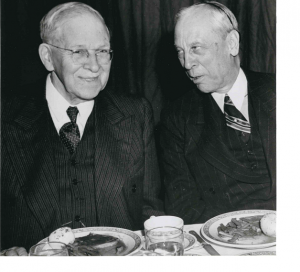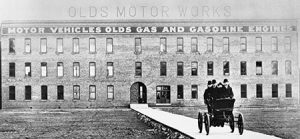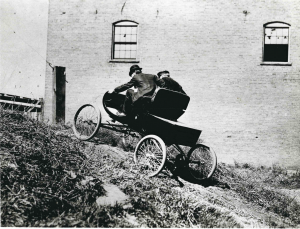By Matt Wolfe
Like grandma placing the turkey in the dining room for Thanksgiving dinner, Detroit set the table for a feast of automotive innovation in the United States. The city was stuffed with automotive pioneers serving up new ideas like Henry Ford and his moving assembly line, Alfred Sloan’s organization of General Motors, and the Fisher brothers refining the construction of automotive bodies. However, it was Ransom Olds who really got Detroit cooking.
 Ransom Olds (pictured left with Alfred Sloan) was one of the first mass-producers of automobiles. Born in Geneva, Ohio in 1864 and raised in Lansing, Michigan, Olds spent his early years building a variety of experimental engines and vehicles. He claimed to have built his first steam-powered car in 1884 and his first gasoline-powered car in 1896. He founded the Olds Motor Vehicle Company in 1897, which was reorganized in Detroit in 1899 as Olds Motor Works.
Ransom Olds (pictured left with Alfred Sloan) was one of the first mass-producers of automobiles. Born in Geneva, Ohio in 1864 and raised in Lansing, Michigan, Olds spent his early years building a variety of experimental engines and vehicles. He claimed to have built his first steam-powered car in 1884 and his first gasoline-powered car in 1896. He founded the Olds Motor Vehicle Company in 1897, which was reorganized in Detroit in 1899 as Olds Motor Works.
The company soon secured five acres of land at 1330 Jefferson Ave near the Belle Isle Bridge along the Detroit River to build a new factory, the first designed specifically for manufacturing automobiles. The plant began operations in March of 1900 and Olds had built a total of 11 prototype vehicles by 1901, including at least one example of a steam, electric and gasoline-powered vehicle. But his vision for automotive mass-production nearly went down in flames.

On March 1, 1901, a fire broke out at the Olds factory and burned the facility to the ground. Olds had just returned from a vacation to find his factory in smoldering ruin and most of his prototype vehicles destroyed. However, one vehicle was saved from the fire; a gas-powered “Curved Dash” runabout. The plans for the vehicle had also survived the fire, as well as the foundry. Though Olds had built other prototype vehicles, he had already selected a Curved Dash as his car of choice to put into large-scale production.
Olds had orders on the books for 334 vehicles at the time of the fire, and a temporary production facility was set up in the foundry. The first production Curved Dashes were built later that year, and it became the first vehicle to be built using a stationary assembly line, as well as America’s first affordable, mass-produced car. Production of the Curved Dash increased exponentially in the ensuing years and by 1903, Olds Motor Works had become the largest automotive manufacturer in the United States.
 Incidentally, the factory fire also led Olds to create the first system of automotive suppliers. In order to keep up with demand, Olds contracted with John and Horace Dodge to provide him with engines and with Henry Leland of Leland & Faulconer to provide transmissions. Olds also was the first to use publicity to market his vehicles. One such stunt involved company test driver Roy Chapin Sr., who drove a Curved Dash all the way from Detroit to New York for the second annual New York Auto Show. The journey took Chapin eight days and, when he reached the Waldorf Astoria hotel, his attire was so soiled from mud that he was asked to use the rear entrance.
Incidentally, the factory fire also led Olds to create the first system of automotive suppliers. In order to keep up with demand, Olds contracted with John and Horace Dodge to provide him with engines and with Henry Leland of Leland & Faulconer to provide transmissions. Olds also was the first to use publicity to market his vehicles. One such stunt involved company test driver Roy Chapin Sr., who drove a Curved Dash all the way from Detroit to New York for the second annual New York Auto Show. The journey took Chapin eight days and, when he reached the Waldorf Astoria hotel, his attire was so soiled from mud that he was asked to use the rear entrance.
Ransom Olds would retire in 1925, having given Detroit’s signature industry a generous portion of innovations. Though he was one of many that helped Detroit become “The Motor City,” his contributions are something everyone in the car business should be thankful for today. Happy Thanksgiving from all of us at the Automotive Hall of Fame!